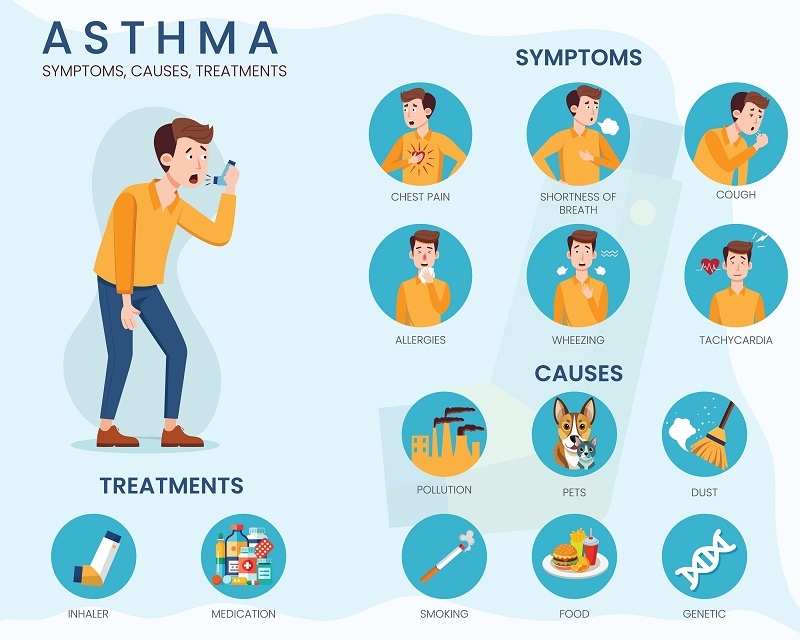
Asthma is a chronic condition that affects millions globally, and proper management of bronchial asthma is crucial for protecting affected individuals and their long-term health. Individuals can enhance their quality of life by knowing triggers, pursuing lifestyle modifications, and following consistent everyday care and physical activities. This manual affords sensible techniques, prevention tips, and proven procedures that assist patients in managing signs and symptoms, reducing risks, and breathing better every day.
Asthma is more than occasional shortness of breath—it’s a condition that requires established care. Poorly controlled hypersensitive reactions can result in moderate flare-ups, medical institution visits, and long-term lung headaches.
It increases the safety of individuals with asthma by identifying their signs and symptoms early and taking action.
Patient protection is a cornerstone of robust hypersensitive reaction control. Mistakes in care or neglect of symptoms can escalate into emergencies.
You can make small changes every day to significantly decrease your asthma use. Lifestyle modifications aren't quite tons of medicine but approximately reshaping behavior for stronger lung function and better overall health.

Managing bronchial allergic reactions correctly and staying ahead of destiny assaults. Prevention pointers are sensible steps for sufferers to reduce exposure to common triggers.
Daily care helps control asthma symptoms and also helps manage them. With the proper routine care behaviors, individuals may maintain better balance.
The role of generation in prescribing allergic reactions is becoming increasingly crucial by permitting sufferers and healthcare professionals to better display and manage allergies. Smart inhalers can, for example, teach how to use prescribed treatments and send reminders to help hypersensitivity sufferers take their dosages on time, decreasing the threat of ignored treatments. Mobile applications help customers record symptoms and signs, identify triggers, and deliver real-time information to doctors for customized care.
Wearable devices can analyze breathing patterns, detect possible signs and symptoms of flare-ups, and communicate information before complications arise. Telehealth platforms also improve patients' access to professional advice in an open and convenient way. This facilitates the opportunity for allergy patients to be more involved in their condition; it enables patients to access and harness their study and utilize it in managing their long-term outcomes.
Helping children with bronchial asthma involves collaborating with the hospital, providing emotional relief, and making changes to routine. Parents/caregivers will be active participants with the health care team and will be responsible for correct medicine use and minimizing contact with allergens. It can be beneficial to educate children on triggers and share how they determine the signs and symptoms of the condition. These actions can give children the confidence to participate in their treatment plan management.
Asthma affects children in any other case and calls for particular techniques for safety and comfort.
Adults spend a large part of their lives at work, making it critical to create workplaces that provide respiratory protection.
A steady method to bronchial asthma control can extensively improve an affected person’s long-term health and quality of life. If patients adhere to their prescribed treatment plans, utilize their inhalers correctly, and identify their triggers, asthma symptoms typically occur less often and with less severity. In the longer term, this reduces emergency department visits, hospitalization, and the risk of developing lasting lung damage. Ongoing avoidance of symptoms also encourages patients to be more physically active and more likely to engage more confidently in their daily care, workouts, and social activities.
Emotional well-being improves as individuals advance over flare-USA.And decrease the anxiety related to surprising assaults. With ongoing medical guidance, lifestyle adjustments, and using supportive generation, patients can maintain robust lung function and save you headaches. The long-term outlook indicates that proactive, regular bronchial asthma management is vital to living a healthier, more lively, and enjoyable lifestyle, regardless of the situation.
Managing hypersensitivity reactions begins with identifying triggers and taking steps to eliminate or manage them. Dust, pollen, smoke, dry air, and stress are common triggers that can make symptoms of the hypersensitivity worse if practical management efforts are not employed. A guide to asthma management can serve different purposes with patients as they work to identify music triggers, their own management plan for medication, and create healthier lifestyle choices for optimal comfort moving forward.
Using devices such as peak flow meters, smart inhalers, and apps related to fitness can help with observing what is going on daily and provide measures to prevent symptoms from changing. With regular management of routine, medical management, and input from the child's family or caregiver,
This content was created by AI